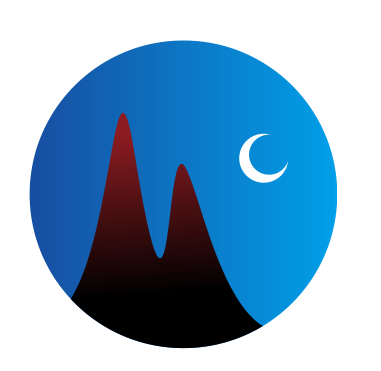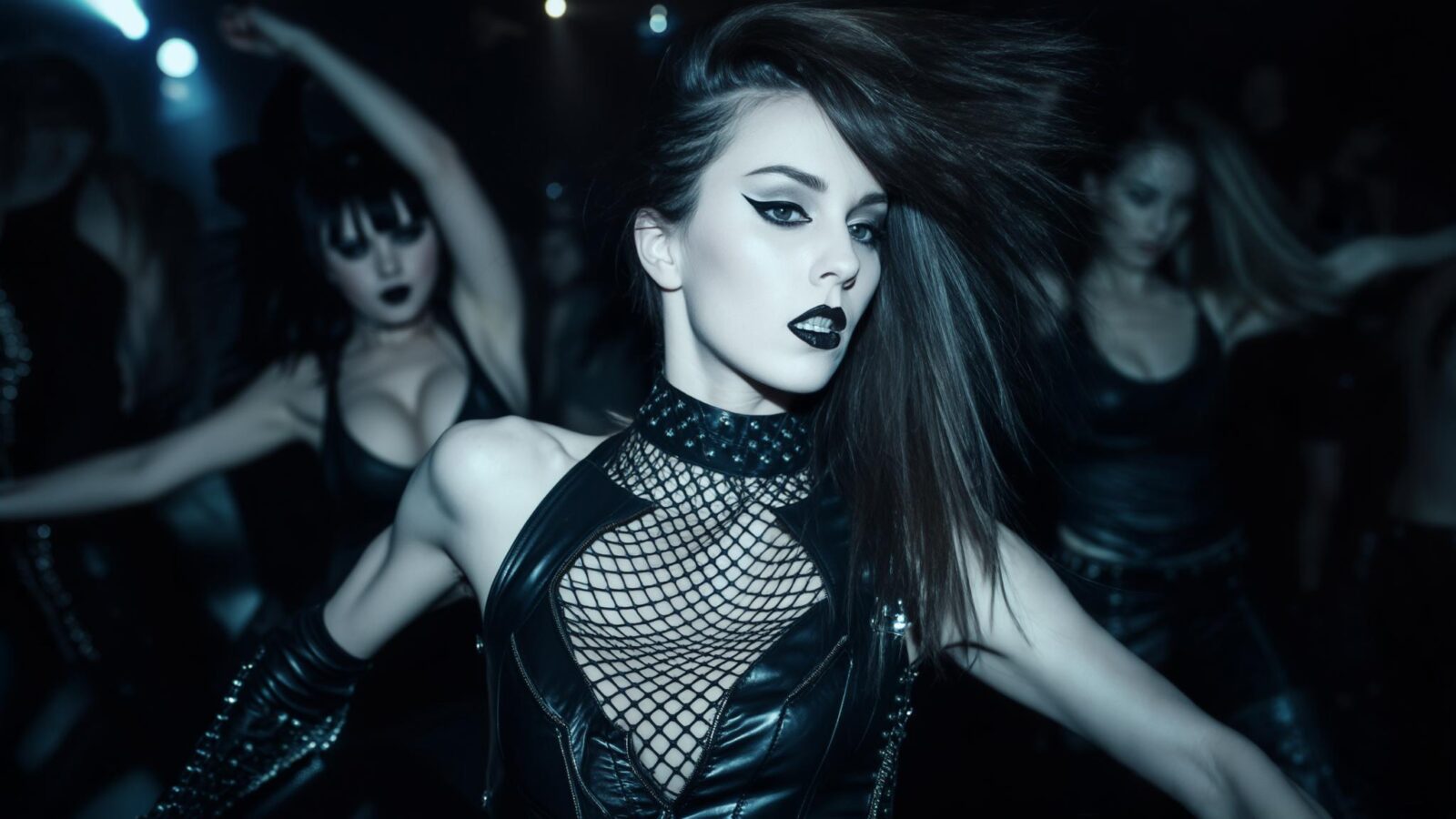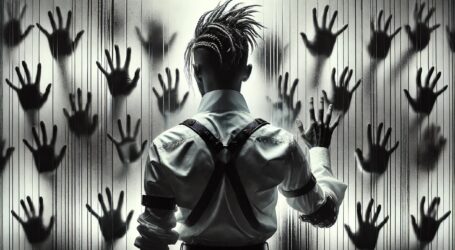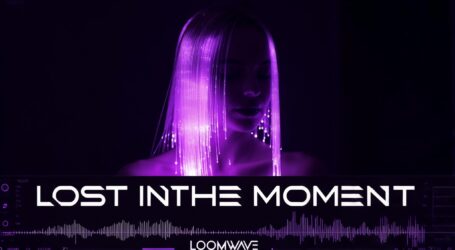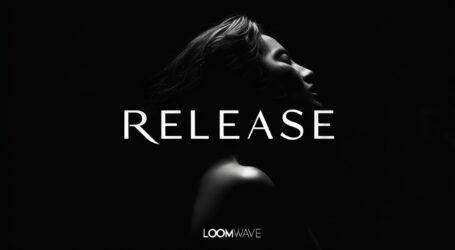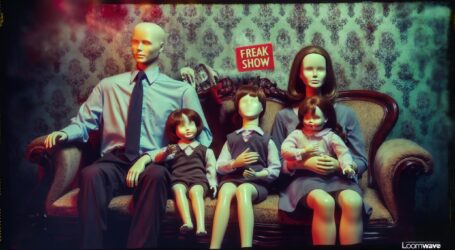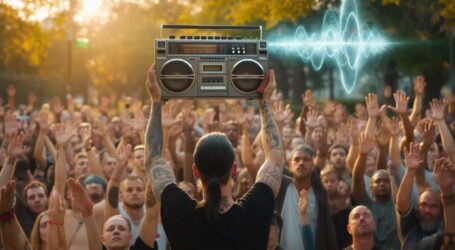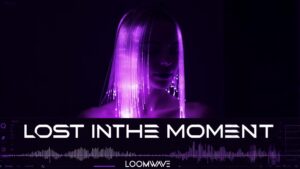Exploring Gothic-Dance Crossovers with Suno 4.5
Today was a productive day for my AI music production journey. After working on several projects, I created a particularly striking track called “Beautiful Darkness” – a gothic-dance fusion that showcases the impressive new capabilities of Suno 4.5’s genre crossover functionality.
What makes this track special is the seamless blend of two seemingly disparate genres: the atmospheric, melancholic qualities of gothic music combined with the energetic, pulsing rhythms of dance. This isn’t a combination you encounter often in mainstream music, which made it an exciting frontier to explore with AI tools.
The Initial Concept and Claude Prompt Engineering
The process began with a clear vision: I wanted to create something that would maintain gothic music’s haunting atmosphere while incorporating dance music’s infectious energy. To achieve this, I turned to Claude AI to help craft the perfect prompt.
Working with Claude, I developed detailed instructions specifying:
- The gothic elements I wanted (atmospheric synths, haunting vocals)
- The dance components (beat structure, bass presence)
- The emotional qualities I was targeting
- Reference tracks and artists for stylistic guidance
The prompt engineering process is crucial – it’s essentially composing with words instead of notes. The more precise and descriptive I can be, the better Suno can interpret my creative vision.
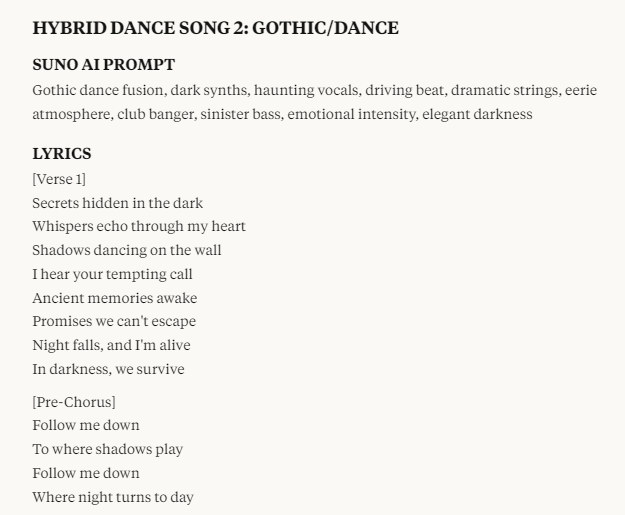
Generating the Track in Suno 4.5
After finalizing the prompt, I headed to Suno and selected their latest 4.5 model, which has dramatically improved capabilities for genre fusion compared to previous versions. I generated several variations of the track to explore different interpretations of my gothic-dance concept.
When the results came in, one version immediately stood out from the rest. As I noted while creating it, “Wow, one of them sounded incredible. The intonation in the pitch and the way that the vocal sounds in one of the Gothic-dance crossovers sounds incredible.”
The vocal performance was particularly impressive – hauntingly beautiful with perfect pitch control that captured the gothic aesthetic while remaining accessible enough for dance music. The track had a natural flow between more atmospheric sections and energetic dance segments, creating an engaging dynamic journey.
I could already tell this track had potential, though I knew it would “have to be remastered very well” in post-production to bring out its full quality. The raw generation already had “a good beat,” but I wanted to enhance the bass presence and overall mix to make it truly shine.
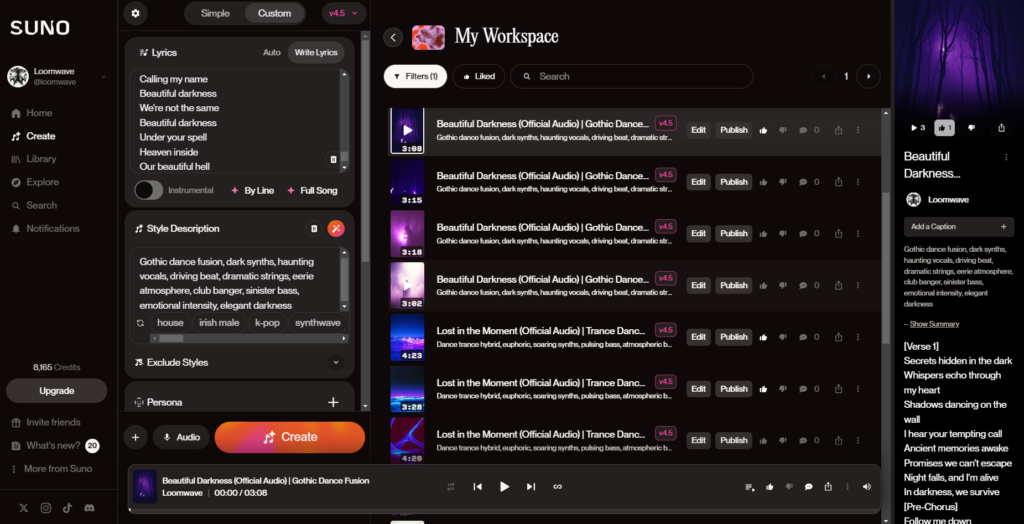
Visual Creation with Luma Dream Machine
With the audio in good shape, I turned to Luma Dream Machine to create album artwork that would visually represent the gothic-dance fusion I’d created. Creating the right visual identity is essential for AI-generated music – it helps establish the mood and gives listeners a visual anchor for the sonic experience.
After experimenting with several concepts, I “stuck with one that had a gothic female body shot of her dancing in a black and white or sepia format.” This image perfectly captured the essence of the track – the gothic aesthetic represented through the monochromatic/sepia treatment, and the dance element embodied in the figure’s movement.
The contrast between light and shadow in the image mirrored the musical contrast between darker gothic elements and energetic dance beats. The vintage-feeling sepia tone also added a timeless quality that complemented the music’s atmospheric nature.
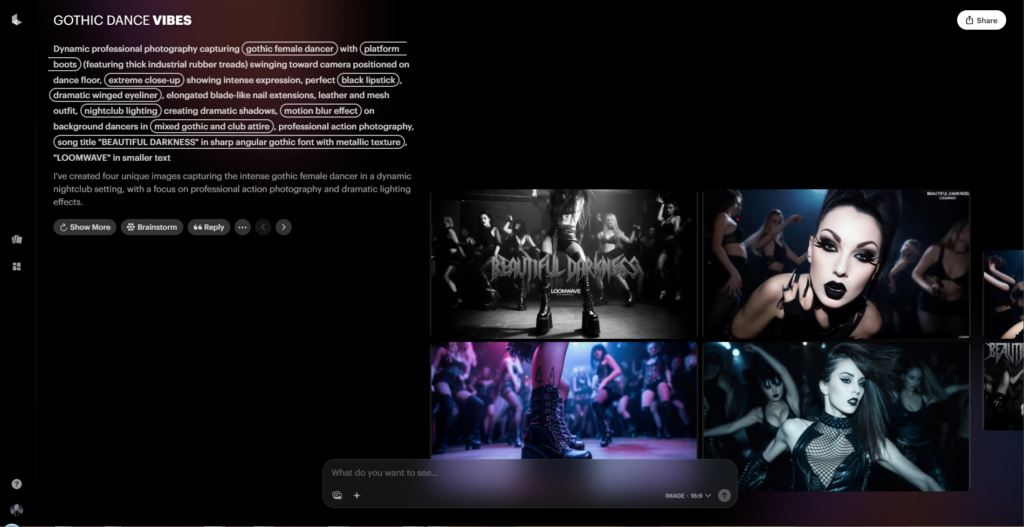
Video Production in VSDC
With both audio and visual components ready, I moved to VSDC video editor to create the complete package. This involved a multi-step process:
- I “added that [image] to the VSDC video editor” as the foundation
- Next, I “added the audio” track, synchronizing it with the visual elements
- Then I “created an audio spectrum” visualization that would pulse with the music, providing visual feedback to the beat
- Finally, I combined all elements and “exported that video” in high quality
The audio spectrum was a particularly important element for this track. Since gothic-dance music relies heavily on atmosphere and rhythm, having a visual representation of those sound waves helps viewers connect more deeply with the music, especially with a static background image.
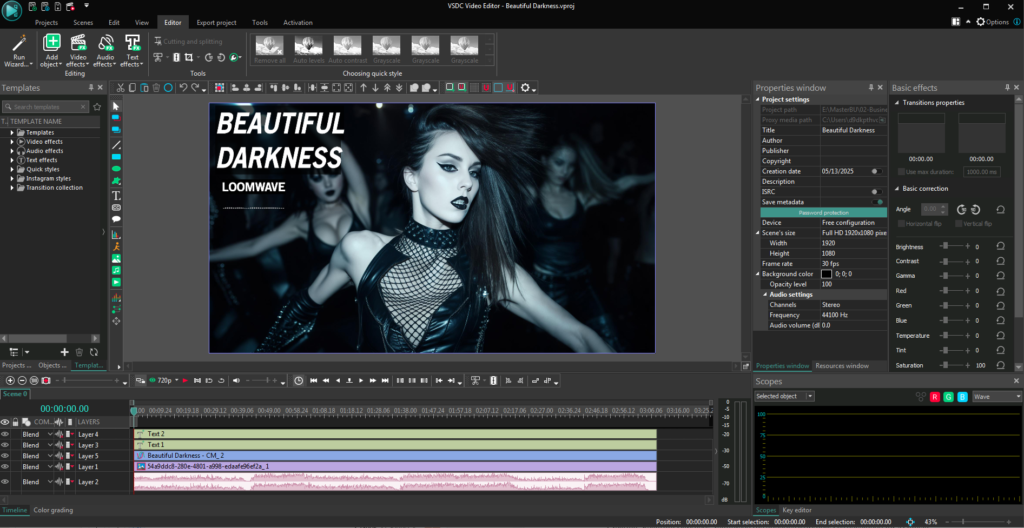
Audio Mastering with BandLab
Before finalizing the track for publication, I took the raw Suno output through BandLab’s mastering tools. As I noted while creating this track, the gothic-dance crossover had “incredible” vocals and a good foundation, but “in post-production it will have to be remastered very well” to reach its full potential.
BandLab’s mastering suite proved perfect for this genre fusion, allowing me to:
- Enhance the low-end frequencies to give the dance elements more impact
- Add subtle compression to balance the dynamic elements
- Adjust the EQ to make the gothic vocals stand out in the mix
- Apply spatial effects to create a more atmospheric sound
- Optimize the overall loudness to industry standards
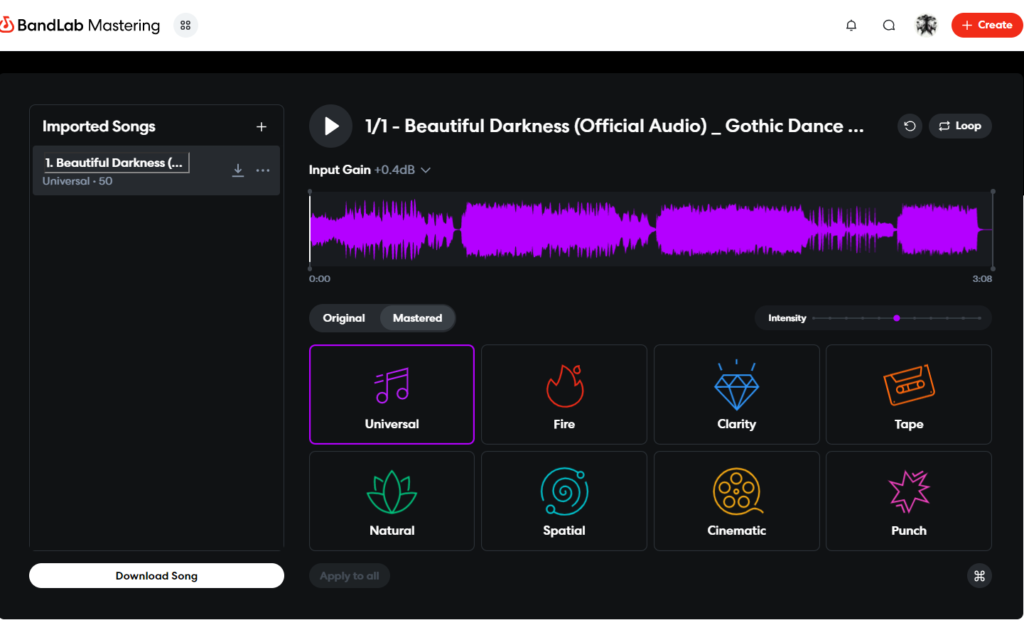
The mastering process was particularly important for “Beautiful Darkness” because of its contrasting elements. The gothic components needed space and atmosphere to convey their haunting quality, while the dance elements required punch and clarity to drive the energy forward. BandLab’s mastering algorithms helped find the perfect balance between these competing needs.
After several iterations, I achieved a final master that maintained the emotional impact of the gothic vocals while ensuring the track would sound powerful on various playback systems – from headphones to car speakers.
Publishing to YouTube
By 12:55 a.m., I had successfully uploaded “Beautiful Darkness” to YouTube, marking another milestone in my growing catalog of AI-generated music. This upload came at an especially exciting time as I’d just received notification that my channel had qualified for the YouTube Partner Program, opening up monetization opportunities.
The timing couldn’t have been better – “Beautiful Darkness” represents exactly the kind of innovative, genre-blending content I want my channel to be known for. The gothic-dance fusion occupies a unique niche that should appeal to both gothic music enthusiasts and electronic dance music fans alike.
Refining My AI Music Workflow
Creating “Beautiful Darkness” reinforced the effective workflow I’ve developed for AI music production:
- Conceptualize: Identify an interesting genre combination or musical concept
- Prompt Engineering: Work with Claude to develop detailed, effective instructions
- Generation: Use Suno 4.5 to create multiple variations of the track
- Selection & Refinement: Choose the best version and identify post-production needs
- Visual Design: Create album artwork with Luma that captures the music’s essence
- Video Production: Combine audio and visuals in VSDC with engaging elements like audio spectrum
- Distribution: Upload to YouTube with optimized metadata and descriptions
This systematic approach allows me to consistently produce high-quality AI music while maintaining creative control throughout the process. Each step builds on the previous one, resulting in a cohesive final product that represents my artistic vision.
The Future of Gothic-Dance Fusion
The successful creation of “Beautiful Darkness” has me excited about further explorations in this gothic-dance crossover space. There’s something compelling about the contrast between dark, atmospheric elements and energetic dance beats – a tension that creates an interesting listening experience.
Now that my channel is monetized, I’m motivated to develop this niche further. The gothic-dance fusion could become a signature sound that differentiates my AI music production from others in the space. There’s plenty of room to explore variations within this hybrid genre – incorporating elements of industrial, synthwave, or even classical music.
What Makes “Beautiful Darkness” Stand Out
What makes this track particularly noteworthy in my AI music catalog is the vocal quality. As I noted during creation, the “intonation in the pitch and the way that the vocal sounds” was exceptionally good. Suno 4.5 has made significant improvements in generating convincing, emotive vocals that don’t have the awkward phrasing or unnatural qualities that plagued earlier AI music.
The gothic vocals float hauntingly over the dance beat, creating a listening experience that’s both emotionally resonant and physically engaging. This is exactly the kind of unexpected combination that AI music generation excels at – bringing together elements that human producers might not typically combine.
Looking Ahead
With my YouTube channel now monetized and tracks like “Beautiful Darkness” showcasing what’s possible with current AI music tools, I’m excited about the future of my AI music production journey. Each new track builds on lessons learned from previous ones, and the rapid advancement of tools like Suno means the creative possibilities continue to expand.
I’ll continue exploring unique genre combinations, pushing the boundaries of what AI music can be, while building an audience that appreciates these innovative crossovers. “Beautiful Darkness” represents not just a single track, but a promising direction for my ongoing creative exploration.
If you enjoyed this breakdown of my creative process, be sure to subscribe to my YouTube channel Loomwave and check out my other AI music productions on the Diary of a Mad Chaos website.

Diary Of A Mad Chaos is a daily diary written from March 1996 until today, of which individual books and book series have been created, namely “The Lost Years” an exploration of young, entwined love, the “Wubao In China (猎艳奇缘)” book series which provides an extensive comparative analysis of the cultural differences between Eastern and Western societies, and the book titled “Foreigner (华人)” an exploration of race relations in Australia.

